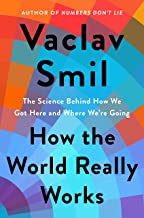Hydrocarbons Support The Four Pillars Of Civilization
Vaclav Smil is a polymath whose prolific writing on energy has produced his latest book, How the World Really Works. You read Smil slowly, taking time to digest the facts and conclusions that are his trade. He combines expertise across several disciplines to explain the technology and inputs supporting modern western lifestyles.
In Fossil Future, Alex Epstein notes the substantial improvements that traditional energy have brought to humanity and argues that we should be celebrating not vilifying the hydrocarbons that make this possible. Smil demonstrates that the world will remain dependent on fossil fuels for the foreseeable future with data-based arguments.
The first three chapters of How the World Really Works, explain how indispensable agriculture, steel, cement and plastics are to civilization. Smil reminds us that, “Modern history can be seen as an unusually rapid sequence of transitions to new energy sources, and the modern world is the cumulative result of their conversions.” He estimates that coal provided half of England’s heat by 1620, but even by 1850 only 7% of fuel energy in Europe and North America.
Shifting the transportation sector to electric vehicles and decarbonizing power generation generate media interest, but start with agriculture to understand how the world feeds its 8 billion people. In 1800 98% of the US labor force was engaged in farming. Producing a kilogram of wheat required ten minutes of labor. Today it’s two seconds – 98% lower, along with the proportion of our workers engaged in agriculture.
The entire production process has benefited from fossil fuels – tractors pull plows manufactured with steel. Combine harvesters collect and process the crop. Propane is used to dry it. Trucks transport it farther down the production line. Refrigeration reduces spoilage. Around 1920 one quarter of US farmland was dedicated to growing feed for the 25 million working horses and mules.
Nitrogen-based fertilizers have dramatically increased yields. Manure, which used to be laboriously spread on fields, contains less than 1% nitrogen whereas urea, the world’s dominant solid nitrogenous fertilizer, is 46% nitrogen. Over the last century corn yields in America have increased from two tons per hectare to 11. Natural gas is converted into ammonia, a key input into urea production. Around the world, farming efficiencies have enabled population growth.
It’s unclear how even small portions of modern food production could be migrated away from traditional energy. There is no known substitute for fertilizers derived from natural gas. Battery-powered farm vehicles are implausible. Returning agriculture to its form of a century ago would leave the world unable to support its current population. It’s not going to happen. Moreover, on current trends we’ll add a further two billion people, mostly in developing countries, by 2050. Smil concludes that, “…without the synthesis of ammonia, we could not ensure the very survival of large shares of today’s and tomorrow’s population.”
Smil refers to cement, steel, plastics and ammonia as “the four pillars of civilization”. Global production of these four “indispensable materials” requires 17% of the world’s primary energy and generates a quarter of fossil fuel CO2 emissions. Cement and steel require substantial heat, generated with coal (or coal dust) and coke. Plastic is a product of hydrocarbons such as methane (natural gas), ethane, propane or oil.
Recycled steel is almost 30% of global steel output and is 70% in the US. It can be melted in an electric arc furnace, which sounds promisingly as if it could be powered with renewables. But the energy required to reach a temperature of 1,800 degrees Celsius is enormous. Even the most efficient furnace requires the electricity of an American city of 150,000 people. Iron ore, from which steel is derived, is almost limitless. World resources are estimated at 800 billion tons, compared with annual production of 2.5 billion tons.
Smil estimates that for Electric Vehicles (EVs) to reach 25% of the global fleet by 2050, output of lithium and cobalt would need to increase by at least 15X; nickel by 28X. He estimates 40 tons of ores per EV. With global auto sales running at 100 million annually, 25 million EVs would mean mining a further 1 billion tons of ore every year.
Concrete and steel are the basis for today’s office towers, apartment complexes, bridges, dams and airports. US cement production peaked in 2005 at 128 million tons. Between 2018 and 2019 China produced 4.4 billion tons, almost as much as America during the entire 20th century.
There are no plausible, scalable methods to produce these four materials without the use of traditional energy. Fears that the energy transition would result in stranded assets of crude oil, gas and related infrastructure glossed over these vital inputs of modern civilization. Much of the growth in energy demand from emerging countries is aimed at building modern cities that emulate OECD countries.
This was always true even when ESG fervor was at its peak, inducing institutional disinvestment spurred on by that tiresome teenager Greta (“How dare you”). Energy reality is returning, rewarding those who relied more on analysis by Vaclav Smil than Climate Czar John Kerry. How appropriate that your blogger composed this on a flight to Houston.
We have three funds that seek to profit from this environment:
Please see important Legal Disclosures.
